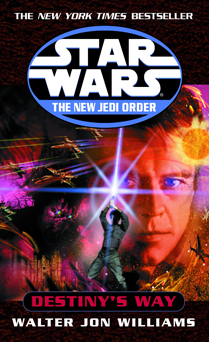“Destiny’s Way” (2002), Walter Jon Williams’ only “Star Wars” novel and the 14th entry in the “New Jedi Order” series, is a transitional book, but a rather good one. It’s easily the best hardcover so far in a series where the paperbacks tend to be much better. Williams doesn’t do anything the best among “Star Wars” authors, but he does almost everything well – monologues and dialogues about the Yuuzhan Vong’s place in the Force, political maneuvering that leads to Cal Omas elected as chief of state, and pacing that allows a reader to enjoy Jacen and Danni picnicking on the Mon Calamari ocean as much as (or more than) the conclusive Jedis-vs.-Vong-warriors battle in the tunnels of a remote moon.
This book is packed with pivotal Expanded Universe information. “Destiny’s Way” is the novel where Jaina is first labeled the Sword of the Jedi; Luke gives her the sobriquet as part of a ceremony honoring the Jedi who took out the voxyn queen back in “Star by Star.” On page 310 of the paperback edition, Luke says: “Yours is a restless life, and never shall you know peace, though you shall be blessed for the peace you bring to others.” After the speech, Luke thinks “He hadn’t meant to say that.” Perhaps the mystery of where Jaina’s destiny comes from, and why, would have been explored in Christie Golden’s “Sword of the Jedi” trilogy, which was canceled in the Disney takeover.
I had never disliked Jaina and Jacen, but this is the first novel where I truly like both of the Solo twins – Jaina for her tireless struggles and preoccupation with death, and Jacen for his newfound confidence coming off of “Traitor.” Except in the arena of romance: It seems that Danni Quee is interested in this newly mature Jacen – inviting him to look at sea life on Mon Calamari – but he’s oblivious to it, recalling that she had rejected him earlier in the series, citing that she’s five years older.
Williams gives fair page-time to a lot of characters. It’s nice to see Tahiri creep back into the fold. She had done most of her mourning for Anakin off-page, and now she’s working with Jacen to develop her Vongsense (Jacen and Tahiri were both Vong captives, with slave implants, for a time). Since Jacen was originally slated to die in “Star by Star,” rather than Anakin (until George Lucas asked the editors to change their plans), the “NJO” team is tiptoeing into this new, grimmer Tahiri just as we readers are. It’s also interesting to note that Danni was originally supposed to play a bigger role in the series – the “Knightfall” trilogy, where she was to be the main character, was canceled. Perhaps Danni and Tahiri somewhat switched roles after the Jacen/Anakin death swap.
The author lightly touches on another dropped thread, as well. Chiss scientists develop Alpha Red, a biological weapon that will wipe out all the Yuuzhan Vong and all Vonglife. This gives Luke and the series’ other moral centers a good old-fashioned time-lock problem that will continue throughout the “NJO”: They have to win the war before the government brings a biological weapon to bear, creating a moral and possibly ecological nightmare. Originally, Lucas Books had toyed with having the Vong invasion corridor start in Chiss space; that concept was ultimately dropped. The Chiss’ contribution to the war effort is a way for the mysterious blue-skinned aliens – whose home planet has never been seen by New Republic representatives – to still play a role in the saga.

The novel reiterates the ideas about the Vong existing in the Force but the Jedi failing to sense them that Matthew Stover introduced in “Traitor”; now Luke discusses the mystery with Vergere, as Jacen had done. I love the way Williams uses examples from Luke’s hero’s journey as points of comparison to enrich both the old material and the new. For example, was Palpatine immoral or amoral, in contrast to the morality of the Old Republic and, later, Luke and the Rebellion? And are the Vong immoral or amoral? The answer to that question might explain Jedis’ ability, or lack thereof, to sense their enemy in the Force.
In a key galactic event, Cal Omas – a former Rebellion fighter — is elected the chief of state, and he proposes a new constitution to address the fact that many senators became blatantly self-serving the moment Coruscant was invaded in “Star by Star.” Among his suggestions to Luke (on p. 444): “Persuade the worlds to elect more responsible senators?” But then he laughs weakly “at his own absurdity.”
I’m happy that Williams answers one big question that had gnawed at me throughout my reading of post-“Return of the Jedi” EU novels: Is Luke’s New Jedi Order funded by New Republic taxpayers? The answer up to this point had always been “It seems to be,” but “Destiny’s Way” gives a definitive yes. (The Jedi Order of the Old Republic is funded by taxpayers without much ambiguity, and it is much more entwined with the government and the military.)
As Luke and Fyor Rodan, a candidate for chief of state, argue about the merits of the Jedi, Rodan says on page 34:
“It would be interesting to conduct a cost-benefit analysis to discover whether the Jedi are in fact worth the resources the government has devoted to you.”
He goes on to note that the Jedi Order should not legally exist as a department of the Republic:
“My point is this – you call yourselves protectors of the Republic; very well. But I have looked very carefully at the constitution of our government, and there is no Office of the Protectors of the Republic.”
Now on to the novel’s problems: As with a lot of the hardcovers that aim to be particularly epic to justify the hardcover status, “Destiny’s Way” does skimp a bit on letting us know the members of Jaina’s Twin Suns Squadron. We know her wingmate’s name is Vale. But all the other non-Jedi in the squadron are known to readers only by their numerical designations. While Williams’ war strategy writing is decent, thanks to the return of aging consultant Admiral Ackbar, the dogfights are overwritten and impersonal – a common problem in everything except the “X-wing” books. And Tsavong Lah, the Vong warmaster, expresses himself almost entirely in exclamation points during the final battle at Ebaq 9, which is a bit over the top.
Another pet peeve: Luke and Mara stash Ben in a safehouse in the Maw. We saw in the “Jedi Academy Trilogy” the stupidity of stashing away your kid for safety, as Anakin Solo was actually less safe on Anoth than he would’ve been with Han and Leia. There would be no safer place in the galaxy for Ben than with his parents, and they’d have the bonus of getting to raise their son rather than missing him terribly. It also feels like a lazy way for the writers to not have to worry about Ben until he’s older and can be made into a full character.
There is one wild, infamous misfire in “Destiny’s Way”: Luke opts to promote all the members of the “Star by Star” mission to Jedi Knighthood. But they were already Jedi Knights. The dramatis personae of every “NJO” book had called them Jedi Knights; indeed, we saw a knighting ceremony for some of them in the final book of the “Young Jedi Knights” series (and note the unambiguous title of that series). The “Destiny’s Way” ceremony could’ve been easily salvaged by simply making it a military-style awards ceremony, or perhaps a renewing of the Knights’ vows, much as spouses sometimes renew their wedding vows.
Still, the good far outweighs the bad in “Destiny’s Way,” which restocks the “NJO” with compelling threads heading into the final five books.

